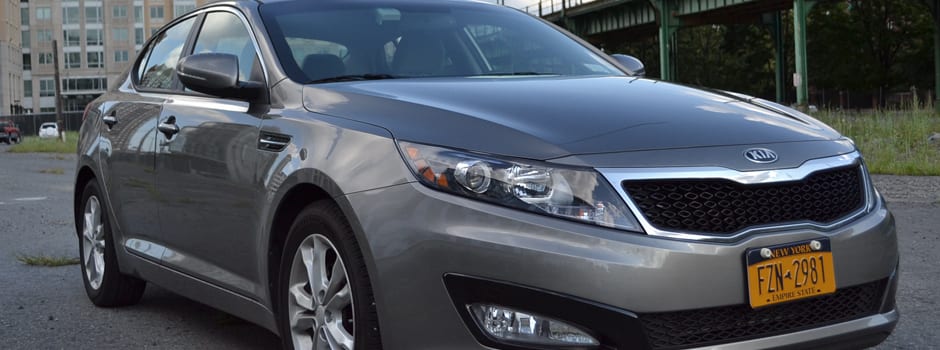Introduction
Tech & Entertainment
On the 2013 Optima, you have to choose between UVO and navigation. Unfortunately, we didn't get either.
All we needed was a tight budget and a map-like mind to navigate these mean streets.
That said, the Optima is available with a couple different tech & entertainment packages. Bizarrely, those packages are often mutually exclusive. Baseline models come with SiriusXM satellite radio, Bluetooth, and a USB and auxiliary audio input. Every trim has the option to add UVO, an infotainment and voice recognition service that Kia developed with Microsoft. It's similar to Ford's SYNC.
If you do, beware, because adding UVO means deleting the navigation system, and adding a nav system means deleting UVO. Each has its own touchscreen and user interface, and like Montague and Capulet, the two shall never live together on the same dash. It's a bizarre oversight, and a sloppy one. We got some time with a top-of-the-line SXL featuring navigation, and its voice recognition required exact prompts that made hands-free use a chore. It would be great to have the natural speech recognition of UVO, but the union was not to be.
Kia is updating their navigation and infotainment for 2014, and we're hoping that includes the Optima.
Design
Though sibling to the Hyundai Sonata, you'd be hard-pressed to tell looking at them side-by-side. While the Sonata has the slightly staid look of a typical mid-seized sedan, the Kia Optima is edgier. We can thank the design influence of Peter Schreyer here, Kia Motors' president and chief design officer, who joined the company after leaving Audi to give Kia a unified design language. He's now in charge of Hyundai's designs, too, so we'll see what his pen draws up.
The look starts at the front grill. Kia dubs it the "tiger nose," but we think it looks like a Ninja Turtle. It's lean, hungry, and ready to eat up some road. (Be assured, though, that it received 5-star safety ratings in nearly every test.) The stretched headlamps give it a sporty look, and if you view it from the rear you'll notice little echoes of the same lines as the front. It's this attention to detail that makes it stand out from its class. The only thing we'll dock points for is air vents on either side in front of the doors, which look a bit like gills.
{{photo_gallery "Driver Side Exterior Photo", "Passenger Side Exterior Photo", "Front Exterior Photo", "Back Exterior Photo", "Front DS Angled Exterior Photo", "Front PS Angled Exterior Photo", "Back DS Angled Exterior Photo", "Back PS Angled Exterior Photo", "Grills & Detail Exterior Photos", "Grills & Detail Exterior 2 Photo", "Under the Hood Photo", "Trunk Open Exterior Photo", "Gas Tank or Charging Port Photo", "Wheels & Wheel Space Photo", "Sunroof Photo", "Convertible Top Down Photo", "Exterior Other Photos"}}
Inside, the experience doesn't quite match up to what was promised from the outside. Not that it's bad, it's just not great. You'll find an array of plastics and fake leathers, all of which look and feel alright, nothing more. It's a driver-centric interior. The center stack is canted towards the left, which may make your passenger feel like a second-class citizen. The absurdly low-slung passenger seat only makes things worse. We're not sure if this was just the trim that we drove, but the passenger sat about 6-8 inches lower than the driver. Frankly, it was a little embarrassing to sit in what we will henceforth refer to as the "time-out chair."
If you don't really care about passenger comfort, so much the better, because it's rather comfortable from the driver's seat. There's plenty of room for everything, sometimes too much room. The arm rests are where you want them and the storage pockets are tucked away in the right spaces. The steering wheel doesn't feel cheap, nor does the faux-leather gear shift. Reach for the stereo, however, and you'll be grabbing thin air, as it's pretty far away. In our tests, the secondary controls on the steering wheel ended up getting a lot of use.
The Optima's roominess carries over into the rest of the interior, with a decent amount of backseat room. The car actually nears the upper limit for what is considered a mid-size sedan at 102.17 cu. ft. passenger volume.
{{photo_gallery "Driver Side Door Open Photo", "Steering Wheel & Dash Photo", "Gauge Cluster Photo", "Center Stack Photo", "Shifter Photo", "Cup Holders & Storage Photos", "DS Inside Door Photo", "Passenger Side Door Open Photo", "In-floor Storage Compartments Photo", "Glove Compartment Photo", "Fit & Finish Photo", "Side Controls Photo", "Back Seat Door Open Photo", "Back Seat with People Photo", "Leg Room Shot at Rear Photo", "Back Seat Folded Down Photo", "Third Row Photo", "Third Row Down Photo", "Trunk Open Empty Photo", "Trunk Open Full Photo", "Spare Tire Compartment Photo", "Interior Other Photos"}}
Driving Experience
The baseline Kia Optima LX and mid-range EX is outfitted with a fairly anemic engine, which is why it usually ends up in rental fleets. Overall, we were still impressed that Kia managed to make as comfortable as ride as they did for the price. At lower speeds, we had more than sufficient oomph to change lanes and pull ahead of sleepier drivers. Even zipping along between 30-50 there was enough power to get the job done and then some, albeit with a heavy foot.
But anything faster than 50mph and the Kia puts its hands up in surrender. We got a chance to drive the same car with a turbo and its apparent that that is a necessary upgrade, even with the $5,400 bump to the SX trim level. Just be careful, because the more powerful engine can put down a ton of power at the front wheels. Electronic stability control did its thing to keep the car on course, but don't be surprised if the wheels spin under heavy acceleration from a stop.
In an EX model without a turbo, there was just no punch at higher speeds. The electric power steering felt a bit imprecise, which (again) didn't really factor in until driving at speed, where we often ended up unintentionally overcorrecting.
Those complaints aside, the Optima feels great — especially for a car in this class. The suspension is just a touch rough, but nothing unsettling, just the result of a long wheelbase. It's quiet a quiet and smooth drive, something a lot of mid-size sedans don't offer in this price range. We should mention again that though this is classified as a midsize, it's just at the cusp of being a full size, so expect some of that "big car presence" behind the wheel.
Conclusion
The 2013 Kia Optima SX is a fairly standard mid-size sedan with one exception: it knows the seductive power of good looks. If its sibling, the Hyundai Sonata, is the staid and responsible Jan Brady, the Optima is definitely Marcia. It's still a sensible Brady, but, you know, it's the one who doesn't have any problems getting a date.
Outside, there's a thoughtfulness to the design that flows through the entire exterior design, including some functional elements, that shows that this one budget-brand is ready for prime time. But inside, the inability to add UVO voice recognition and infotainment and navigation strikes us as embarrassingly amateurish. You'll also want to upgrade to SX trim for the turbo engine.
So, what do we have so far? The Optima looks good, but not too good. It drives comfortably, but not fast. So we come to the third and fourth pillars of a good commuter car: fuel economy and safety. At an EPA-rated 24/35 mpg (city/hwy), you'll be saving money at the pump, but not the sort of savings you get from a hybrid. The Optima does, however, receive top safety picks, with five stars in frontal crash, side crash, and rollover tests.
Trim Levels
In EX and LX trim, the Optima offers a naturally aspirated four-cylinder engine. Step up to the SX or SXL, and you'll get a turbocharged four.
Powertrain
The 2012 Optima was initially available with a 6-speed manual, but for 2013 all trims have a 6-speed automatic. All models are front wheel drive only.
Safety
NHTSA gives the Optima five stars — its highest rating — all around. IIHS gives the Optima top "Good" ratings all around, and names it a Top Safety Pick Plus.
Fuel Economy
In EX and LX trim, the EPA rates the Optima at 24 city, 35 highway, 28 combined. We saw numbers closer to the low 20s in our mixed highway and city drive. The turbo SX and SXL is rated at 22 city, 34 highway, 26 combined.
Meet the tester
David Kender oversees content at Reviewed as the Editor in Chief. He served as managing editor and editor in chief of Reviewed's ancestor, CamcorderInfo.com, helping to grow the company from a tiny staff to one of the most influential online review resources. In his time at Reviewed, David has helped to launch over 100 product categories and written too many articles to count.
Checking our work.
Our team is here for one purpose: to help you buy the best stuff and love what you own. Our writers, editors, and lab technicians obsess over the products we cover to make sure you're confident and satisfied. Have a different opinion about something we recommend? Email us and we'll compare notes.
Shoot us an email

